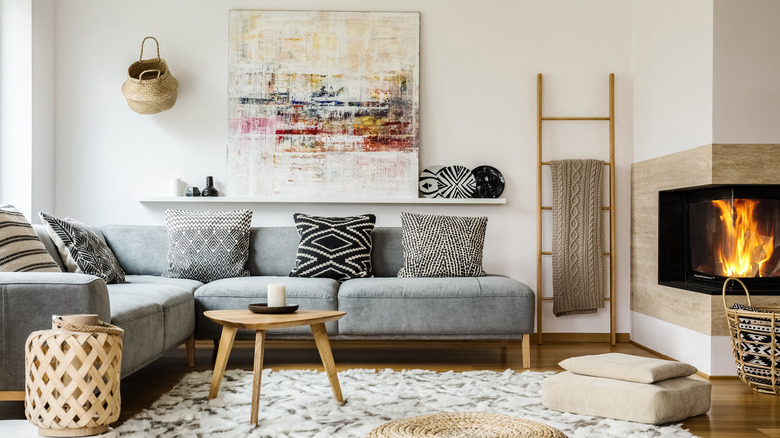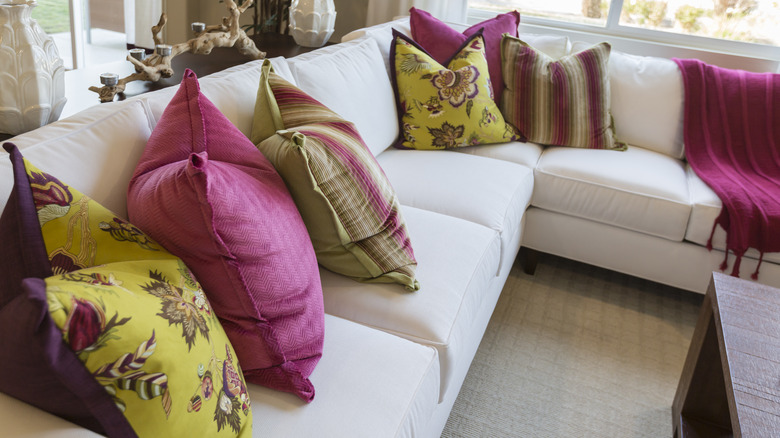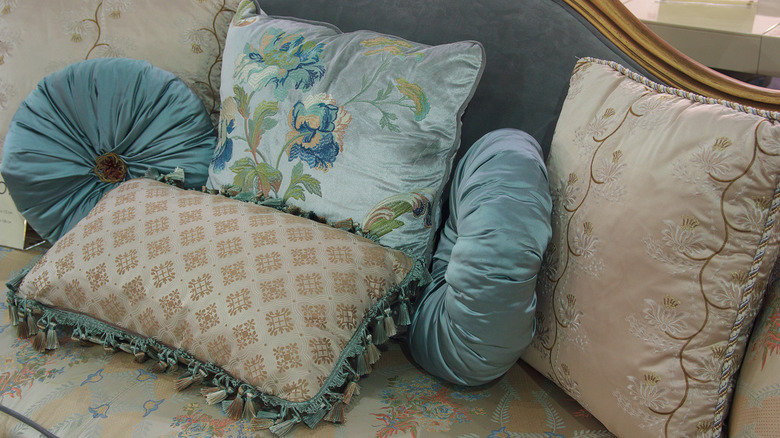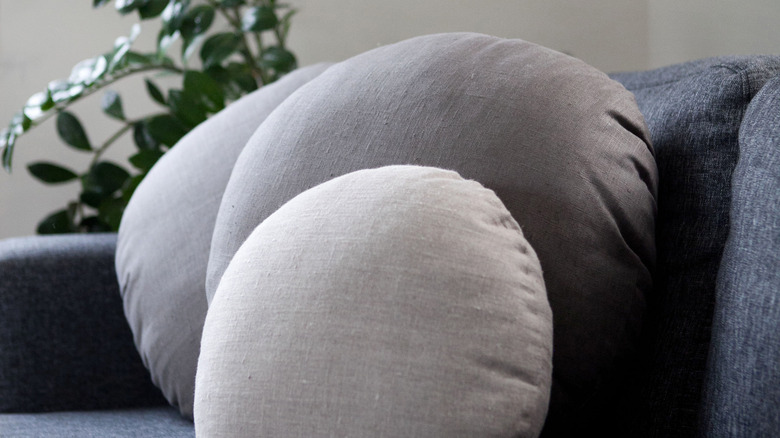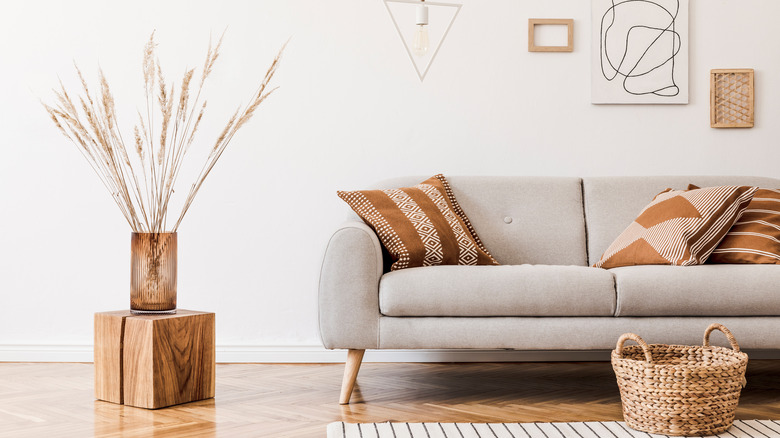4 Simple Tips For Arranging Your Throw Pillows To Get The Perfect Look
Throw pillows and cushions not only serve a very functional role in making your seating extra inviting but can also be an important element in your design scheme. Many designers use pillows as a way to finish or draw together a room in a way that feels stylish and cohesive. Pillows can pull together disparate colors in a room and add pops of bright color and visual interest. They can also layer dynamic patterns and textures that reinforce and establish the aesthetic of the room. According to HK interiors, throw pillows are one of the fastest and most inexpensive ways to transform a space.
Pillows can add a hint of formality or take it away, making a space feel inviting and lived in. With so many options and considerations for your space, you might wonder where to even begin. Consider a few key factors when choosing and arranging your pillows that will instantly transform any room or seating area into the desired look and feel.
1. Color and pattern
Color and pattern usually figure chief among design choices since they are often the things we notice first. Use your throw pillows to echo other shades that appear throughout the room. These pops of corresponding hues draw the eye from each to each, giving your room a dynamic color story. Mustard shades in a piece of artwork pair well with a pillow in the same coloring on the sofa. A berry-colored vase across the room may be an excellent complement to a richly colored cushion. A mix of colors and neutrals can form a nice balance that feels cohesive, even in a mostly neutral space.
Pattern is also essential, particularly as you begin mixing your pillows. Avoid too many pillows in a single pattern or texture. Variation is key. While one or two pillows of the same design may work to bookend a large sofa, smaller sofas can be overwhelmed by too many identical pieces. While mixing patterns can be daunting for the faint of heart, keep in mind two important factors. One, look for patterns that echo the same color or set of colors. Two, vary the scale and size of the print. Too many large florals, even complimentary ones, can be too much. But a large floral paired with a smaller floral or a flattering stripe can be just right. A hint from Lydi Out Loud: Even pillows that might not seem to go together can work if there is a transitional piece between them, one that pulls them together in terms of color and pattern.
2. Fabric and texture
Texture is an important element often overlooked, but it can significantly affect how the pillows feel and appear. Varying textures can even change the impact of pillows in similar shades. According to Posh Pennies, this works particularly well for neutral rooms, where the layering of greys or beiges in various textures adds visual interest. An assemblage of cream pillows in linens, cotton, and nubby woven fabrics is an excellent way to shake things up.
Texture adds variation and sensation to soft surfaces, so consider other tactile elements like fringe, beading, and embroidery. Find textures that compliment both your design scheme and each other, like thick woven fabrics and crisp cotton. Or sumptuous velvet coupled with an intricate brocade. Variation in textures gives a laid-back, eclectic feel to any room that feels very intentional, both visual and tactile. Imagine sinking into a wintertime couch decked out in sweater-soft chenille and fur cushions. Or the instantly romantic feel of satin and embroidered pillows.
3. Shape and size
A casual stroll through any home dcéor retailer can present an overwhelming sea of options spilling from those gigantic shelves and bins. With so many shapes and sizes, there are a number of things to look for when choosing additions to your space. Classic squares are always a safe option, dominating most selections and often being the comfiest addition to any sofa. Rectangles, however, work well for upholstered pieces with lower backs and smaller scales. Round and cylindrical pillows are surprising elements to add to your seating, offering a geometric balance between right angles and curves. They are often the best choice for more informal and laid-back design schemes, while square and rectangular pillows hint at formality.
According to Parachute, size is one of the most important factors to consider. While throw pillows come in a wealth of sizes, consider the scale of the piece they will inhabit. Large, overstuffed couches welcome luxuriously fat pillows. Sleek modern sofas require a little more restraint with cleaner lines and more defined shapes. Also, consider how you use your sofa, as cushions can sometimes take up valuable real estate for seating if too large or overstuffed.
4. Pulling it all together
With so many gorgeous choices, you might wonder how to determine where to stop. The perfect number of pillows may be primarily determined by personal taste. One or two well-placed cushions are ideal if you're on the minimalist side. For maximalists, the only thing stopping you is how many are too many. Before you fall into a sea of softness that swallows you whole, there are some things to keep in mind when arranging your pillows to help answer your question.
Consider whether an even or odd number suits your aesthetics. A sofa bookended by matching pillows has a symmetrical and more formal feel. Add a third, and it instantly becomes more informal. Groupings of three and five may be ideal if your room aesthetic is more casual and laid back. If you're going for a more symmetrical, streamlined look, choose two or four. Most common advice indicates that a large sofa can house up to five pillows, while a smaller chaise or loveseat looks best with three. A chair can usually accommodate one, though a wider, deeper lounger may be perfect with one larger and one smaller pillow. According to Ballard Designs, arrange your cushions from the outside in, with larger pillows at the ends and smaller pillows toward the center or in front of the bigger ones. This will not only keep the small ones from getting lost but will maximize seating space.
